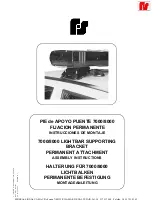
the tire, both front-to-rear and side-to-side, when
tightened. Also, take care that the strap is not twisted
and cannot rub or chafe. Be sure to secure the end of
the straps to prevent them from damaging the finish of
the towed vehicle or dolly.
Repeat this procedure on the driver’s side. (See
“Unloading the dolly,” on page 11, for instructions on
how to release the TieDown strap.)
The TieDown straps must be retightened after
towing the first five miles. Check the TieDowns
every 100 miles thereafter for tightness, as well as
for any chafing or rubbing. Road vibrations may
cause the TieDown straps to loosen during towing.
If the TieDown straps are not tightened, the towed
vehicle may separate, which will cause property
damage, personal injury or even death.
15.
Hook up your auxiliary lighting for the rear of the
towed vehicle. Test the lighting for proper functioning
before towing.
Note: Nearly every state requires lighting at the rear
of the towed vehicle. ROADMASTER manufactures
three lighting systems. See “Electrical kits,” under
“Optional equipment and accessories,” for a full
description.
Towing
1.
Before towing any vehicle for the first time, test to
ensure that the vehicle will not come into contact with
the dolly’s fenders. Vehicles with fender flares, or fend-
ers that overhang the wheels, are especially susceptible
to damage of this kind.
First, make certain that the towed vehicle is centered
on the dolly.
In an empty parking lot, have someone watch as
you slowly turn sharply to see whether you have this
potential problem. Damage that results from turning too
sharply is not covered by warranty.
continued on next page
continued from preceding page
If the TieDown straps are touching a strut or
other component, road vibrations may cause the
straps to be chafed while towing, which may cause
the strap(s) to separate, resulting in property
damage, personal injury or even death.
Notice that the hook will always go toward the rear
and that the buckle
will always be on the
outside of the tire.
Identify the passenger
side strap and install it
on the tire, as shown in
Figure 7.
Position the hook so
that it is centered with
the tire. As close as
possible, adjust the diameter of the buckle strap so
that the front and rear of the strap engage the tire just
above the 9:00 and 3:00 positions. Rotate the buckle
strap around the tire, so that the strap is just forward
of the center of the wheel.
Next, pull the strap through the buckle so that the
buckle is tight around the tire (Figure 8).
Be certain that the TieDown
™
strap is routed
through the buckle, as shown in Figures 7 and 8,
before towing. The strap will not secure the towed
vehicle if the strap is not routed through the buckle
correctly. Failure to properly route the strap will
cause the strap to loosen, which may result in
property damage, personal injury or even death.
The crossover strap (Figure 7) should be centered
at 12:00. In addition, center the
ratchet with the tire, by sliding it left
or right as necessary.
Now, take the front end of the
strap and feed at least six inches
through the slot in the ratchet. Tight-
en the strap by raising and lowering
the ratchet handle, as shown in the
photo to the right.
The strap is suf-
ficiently tight when the tire begins to flatten against the
ramp stop.
The ratchet handle must be in the down position
when towing to properly secure the TieDown straps.
If the ratchet handle is up, the strap may loosen
during towing, which may cause the towed vehicle
to separate from the dolly, resulting in property
damage, personal injury or even death.
Be certain that the TieDown strap is centered on
Push lever
down
Feed strap
from back side
and through
Figure 8
USING YOUR TOW DOLLY
10
Figure 7






































